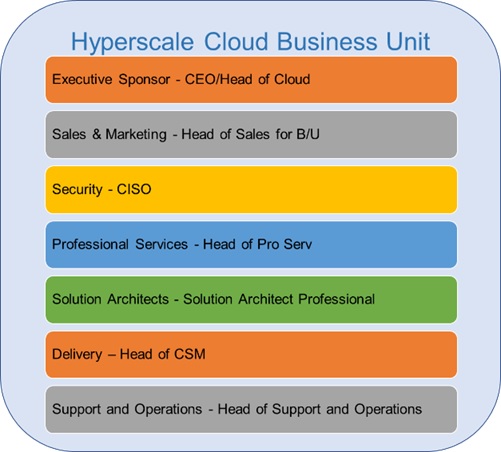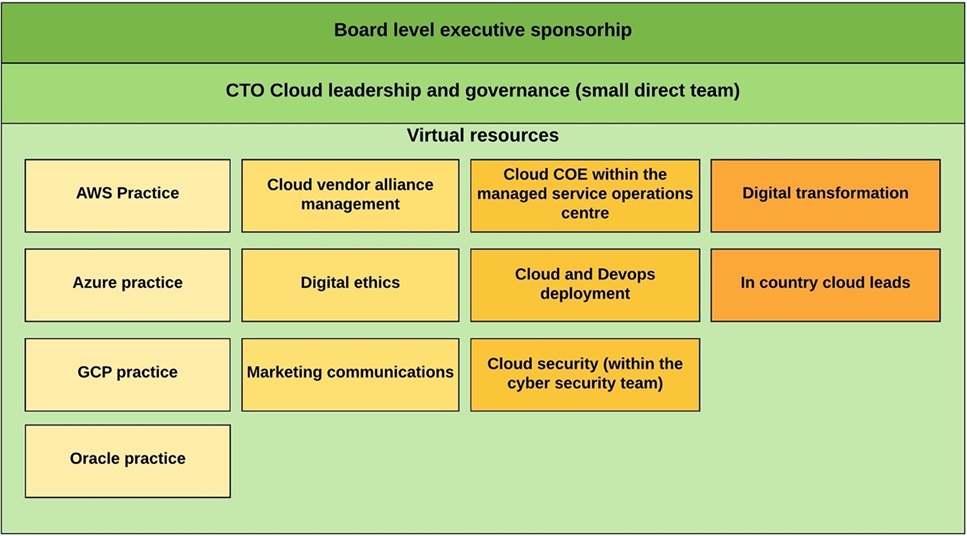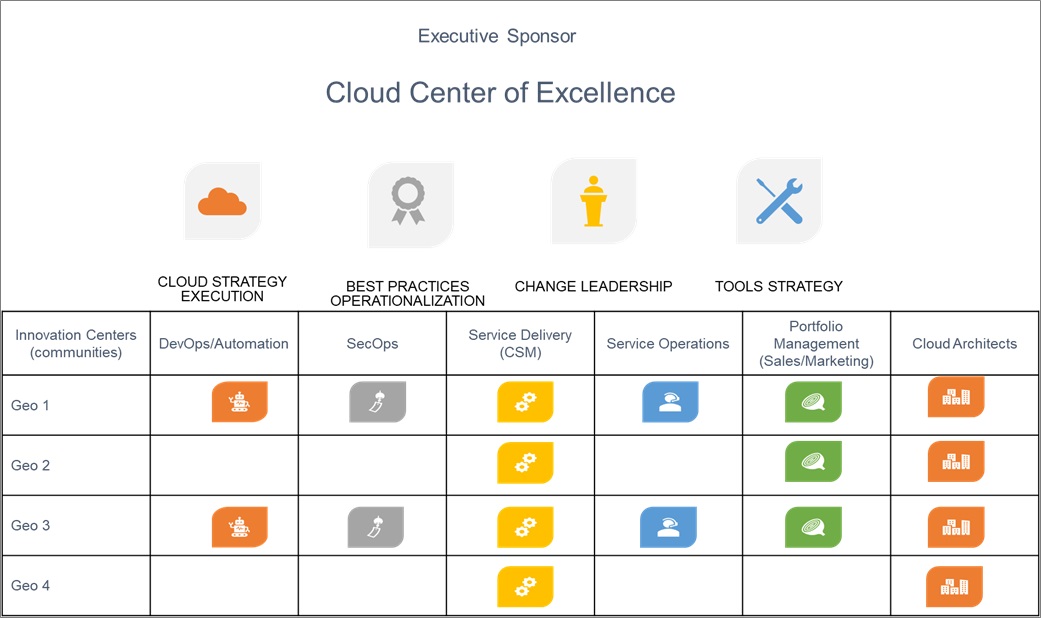AWS Partner Network (APN) Blog
How a Cloud Center of Excellence Spurs Innovation and Competitiveness
By Eric Carlo, Global Head of Consulting at ISSI
By Mike Williams, EVP for Business Development at ISSI
 |
 |
 |
In today’s fiercely competitive IT landscape, many AWS Partner Network (APN) Partners face the same challenge as end customers: how do you manage ever-accelerating cycles of innovation to stay relevant?
ISSI, an APN Select Consulting Partner, is a consulting, auditing, and marketing company focused primarily on Managed Service Provider (MSP) channel partners.
We have worked with more than 300 partner organizations worldwide, including more than 100 hyperscale cloud MSPs, from small, local, and regional shops to large companies with global reach.
In our experience, APN Partners who stay on top of the innovation cycles are the ones who have established a Cloud Center of Excellence (CCoE). Implementing a CCoE is critical not only as an accelerant to a partner’s business, but also for gaining the knowledge and expertise required to help end customers navigate and leverage the incredible potential of cloud technologies.
In this post, we’ll share our understanding of CCoE design and practical implementation for MSPs, and how actual MSPs have structured their CCoE to fit their specific size and particular regional or global span.
This is not an exhaustive look into how to build a Cloud Center of Excellence—that is best done through in-depth workshops—but it will provide enough information to kick-start your internal conversations.
What is a Cloud Center of Excellence?
A Cloud Center of Excellence can be defined as a centralized team within a company that includes stakeholders from core teams such as solution architects, sales, marketing, finance, and operations.
The CCoE’s mission is to discover, adopt, and evangelize existing and nascent cloud technologies, and to ensure alignment between the technologies and the company’s business and technical strategies.
In its 2020 Planning Guide for Cloud Computing that is targeted to enterprises, Gartner outlines what it calls the “three pillars” of a Cloud Center of Excellence: governance, community, and brokerage.
The governance pillar involves execution of a company’s cloud strategy using well-defined and enforced enterprise-wide standards and best practices. People responsible for governance frequently participate in industry events, advisory councils, and other external activities to learn about and incorporate new trends and best practices.
The community pillar includes effective management of enterprise talent—including hiring and assigning people to roles involved in implementing best practices. It also includes creating internal innovation councils, and ensuring all roles are correctly aligned to long-term corporate strategy.
Finally, the brokerage pillar involves assessment of and planning for the implementation of cloud technologies. In enterprises, this is typically controlled by the IT department. Within MSPs, the brokerage pillar is important not just for a partner’s internal business operations, but also for delivering consulting services to end customers.
Breaking Down Barriers to Transformation
By implementing a CCoE using the pillars described above, any company is well on its way to transforming its business using cloud technologies. Along with Gartner’s pillars, we would add one other critical element: a change leadership role that’s articulated in a company’s cloud strategy and executed by the CCoE.
Change leadership is essential in helping break down what Gartner lists as barriers to business transformation:
- Change-resistant culture.
- Limited sharing and collaboration.
- Gaps in talent needed to implement and manage new technologies.
- Business practices that don’t support the talent.
- The time and resources needed to implement change.
A successful cloud strategy addresses these barriers with mitigating strategies and a change management competency for the CCoE to execute, clearing the way for a company to innovate and transform itself in the cloud.
To give just one example, suppose a company has a change-resistant culture. A mitigating strategy would involve ensuring the organization overcomes resistance to change by getting initial buy-in from senior executives. It would also be important to work on reducing hierarchies, eliminating team silos, encouraging collaboration, and fostering communications to find new ideas that drive innovation.
Common CCoE Scenarios
In our experience at ISSI, there are two common Cloud Center of Excellence design scenarios. We call them the “project role” and “governance role” scenarios. Let’s take a closer look at what they entail.
Scenario 1 (Project Role)
In this scenario, the CCoE is created as a project to help lead a migration to the cloud from a traditional on-premises IT environment. The company’s operations and growth are hampered by siloed teams. This can include product development, data center management, hardware and software purchasing and deployment, database administration, application and technical support, break-fix support, and help desk support.
The CCoE is guided by the company’s cloud strategy, and is tasked with helping the organization innovate faster and create new business opportunities. This is done by taking advantage of cloud features, such as hyperscale scalability, elasticity, and resiliency. All of these features are required by today’s business applications to deliver on the demands of the digital economy.
The CCoE is also responsible for articulating and supporting organizational change management that’s identified in the company’s cloud strategy.
At the beginning of the transformational initiative, the CCoE starts with a small number of team members, and then grows to a more significant number representing each cloud capability outlined in the best practices. The role of the CCoE is to ensure cloud best practices are operationalized in sales and marketing, professional services, solution architects, delivery, and support and operations.
Scenario 2 (Governance Role)
In the early stages of cloud initiatives, we find that CCoEs are often created for projects like the one outlined above. In this scenario, once the project is finished and cloud best practices are operationalized, the CCoE is viewed as no longer necessary.
However, rapid innovation cycles in cloud computing that include a constant stream of new products, features, and native-tool releases validate the need for a centralized body of knowledge. This helps to ensure an organization continues to operationalize best practices at scale.
In this scenario, the company recognizes the CCoE should be a permanent fixture. It has a defined charter, clearly articulated roles and responsibilities, and is staffed by individuals responsible for creating, educating, leveraging, and operationalizing cloud frameworks, tooling, and governance.
Over time, best practices are established in areas such as DevOps, SecOps, automation, support, customer success management, product management, cloud operations management, talent management, and finance.
What is the Appropriate Structure for a CCoE?
When creating a Cloud Center of Excellence, you should take into consideration your company’s size, culture, and global reach.
Depending on the scenario and purpose, the CCoE may expand or contract based on the organization’s needs. However, a core group representing key teams across the organization should always remain to provide governance over the cloud functional capabilities.
When starting on a CCoE, it’s important to coordinate with talent management leaders to ensure that employees and job roles are properly aligned with the CCoE strategy. For example, if a particular team decides to hire specialists in Internet of Things (IoT) or databases, but a central CCoE strategy focuses on lowering costs, then there will be a misalignment between strategy and staff roles. This often leads to lost time, money, and opportunities.
The following illustrations are based on actual CCoE implementations by MSPs we have worked with at ISSI.
Figure 1 shows how a relatively small, regional MSP with fewer than 150 employees set up its CCoE. You see the involvement of senior executives and department heads, which is common in smaller organizations.
Figure 1 – Regional MSP with fewer than 150 employees.
The next illustration reflects the CCoE designed by a mid-sized MSP operating in multiple countries. The CCoE reflects the company’s business model, which includes more than one cloud practice.
Figure 2 – Medium-sized multinational MSP with more than one cloud practice.
Finally, this last illustration shows the CCoE of a large, global MSP. The CCoE’s responsibilities vary based on the needs of specific regions, and it works with the company’s established center of innovation.
Figure 3 – Large, global MSP operating in multiple regions.
Benefits of a Cloud Center of Excellence
We have seen Managed Service Providers that succeed in the long run because they have established a Cloud Center of Excellence to ensure technology innovations are consumed and operationalized in the organization.
We have also seen companies that do not have a CCoE lose the ability to innovate quickly—and their ability to stay competitive. In more than a few instances, we’ve seen organizations scramble to establish a CCoE after realizing the costs of not having one in place.
In some circumstances, it can be a requirement to have an established Cloud Center of Excellence. The AWS Managed Service Provider (MSP) Partner Program requires that MSPs build and maintain a CCoE to leverage best practices across all of their offered services.
One of our clients was a well-established MSP that attempted to start its cloud practice by acquiring smaller companies. However, there was no central strategy in place to guide this company on leveraging its new technologies and talent. Not surprisingly, they struggled to profit from the acquisitions.
When we began working with this particular client, one of our first recommendations was to establish a Cloud Center of Excellence. Within three months of establishing the CCoE, the company had achieved an important cloud competency designation and was well on its way to greater profitability.
That’s just one example of a CCoE supporting innovation and profitability at the speed of the cloud.
A Cloud Center of Excellence helps a company embrace disruptive cloud technologies to achieve greater profit margins, improve operational margins, and establish recurring revenue through customer stickiness. A CCoE fosters agility as individuals and teams grow comfortable with the easy-to-use, low-cost, experimental nature of cloud services.
Conclusion
Regardless of your company’s organizational hierarchy, culture, and regional span, there is a need for a centralized body of knowledge for decision making, strategy execution, governance, policies, and best practice implementation when working with cloud technologies.
This centralized body of knowledge is called the Cloud Center of Excellence.
There is no single way to design a CCoE that fits all business unit sizes and cultures. The CCoE is an adaptive body of knowledge that will change to align with an organization’s needs. Over time, companies that recognize the need for and implement a CCoE can leverage the benefits of fast, continuous cloud-based innovation.
For more information about designing and implementing a Cloud Center of Excellence, visit the ISSI website or email info@issi-inc.com.
On-Demand Webinar for AWS MSPs
Check out our on-demand webinar to learn more about ISSI’s MSP consulting offerings and how you can build a Cloud Center of Excellence to spur innovation and competitiveness; APN Partner Central login required.
The content and opinions in this blog are those of the third party author and AWS is not responsible for the content or accuracy of this post.
ISSI – APN Partner Spotlight
ISSI is an APN Select Consulting Partner. They are a consulting, auditing, and marketing company focused primarily on Managed Service Provider (MSP) channel partners.
Contact ISSI | Practice Overview
*Already worked with ISSI? Rate this Partner
*To review an APN Partner, you must be an AWS customer that has worked with them directly on a project.



